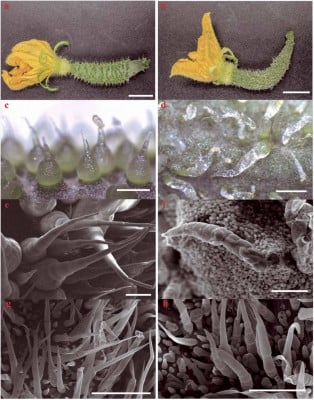Trichomes are hair-like projections found on the surface of many plants, offering protection against environmental stressors and insects, while also influencing commercial appeal. In cucumbers, multicellular trichomes—fruit spines—are especially prominent and variable, yet the genetic mechanisms driving their formation remain elusive. Studies in model plants like Arabidopsis have shed light on trichome biology, highlighting the roles of cytoskeleton dynamics, transcriptional regulation, and hormone signaling. However, cucumbers possess distinct spine morphologies and cellular architectures that demand crop-specific exploration. Due to these complexities, there is a critical need to investigate how cucumber plants coordinate internal cellular processes to sculpt their outermost structures.
A research team at Shanghai Jiao Tong University has identified the cucumber gene CsTs as a pivotal regulator of fruit spine development and texture. The study (DOI: 10.1093/hr/uhae235), published August 14, 2024, in Horticulture Research, demonstrates how this single gene controls spine formation by modulating cell division, wall composition, and intracellular transport. Employing gene-editing, microscopy, and protein interaction analyses, the researchers unveiled a sophisticated genetic network behind cucumber surface architecture. The findings illuminate key processes in plant development and lay a foundation for enhancing crop quality through targeted genetic strategies.
To confirm CsTs’s role, scientists generated knockout cucumber lines using CRISPR/Cas9, resulting in trichomes that were flattened and malformed—mirroring the naturally occurring “tender spine” mutant. Microscopy revealed a lack of structural differentiation between the stalk and base of the fruit spines, leading to loose attachment to the fruit surface. Biochemical analysis showed these mutants had reduced cellulose and lignin but elevated levels of pectin and hemicellulose, weakening cell wall rigidity.
Transcriptomic profiling across developmental stages revealed that CsTs influences gene networks related to auxin transport, cytoskeletal arrangement, and secondary metabolism. Protein interaction studies identified direct partners such as SNARE proteins and ROP GTPases—key players in vesicle trafficking and cell polarity. These interactions were lost in the mutant due to protein mislocalization. Interestingly, overexpressing CsTs in an Arabidopsis homolog mutant partially restored normal trichome morphology, suggesting functional conservation across species. Additional genetic analysis indicated that CsTs operates in the same pathway as CsMict, a gene involved in cuticle formation, although the two proteins do not interact directly. Together, the findings position CsTs as a critical node in a network that shapes cucumber spine morphology through tightly coordinated cellular and molecular processes.
“Our study reveals that CsTs is not only essential for cucumber spine development but also plays a broader role in organizing cellular architecture,” said Dr. Junsong Pan, the study’s lead investigator. “By pinpointing how this gene influences cytoskeletal structure and hormone transport, we’ve uncovered a key mechanism in plant surface biology. This opens new possibilities for improving crop resilience and appearance through genetic approaches.” He added that future research would explore how CsTs coordinates signaling cascades through phosphorylation and how it may interact with broader metabolic pathways in plants.
The identification of CsTs offers valuable opportunities for breeding cucumbers with customized spine textures, enhancing both marketability and pest resistance. By manipulating this gene, breeders could potentially develop varieties that are tougher, more aesthetically uniform, or better protected from insects such as aphids, which tend to favor softer mutants. Moreover, insights into how CsTs regulates cytoskeleton and cuticle biosynthesis could extend to other crops where trichomes affect flavor, texture, or defense. As scientists further explore the genetic pathways linked to CsTs, the work could lead to innovative strategies in sustainable agriculture and precision horticulture.
###
References
DOI
Original Source URL
https://doi.org/10.1093/hr/uhae235
Funding information
This study was supported by the National Science Foundation of China (32302540) and the Postdoctoral Science Foundation of China (2023 M732328).
About Horticulture Research
Horticulture Research is an open access journal of Nanjing Agricultural University and ranked number one in the Horticulture category of the Journal Citation Reports ™ from Clarivate, 2023. The journal is committed to publishing original research articles, reviews, perspectives, comments, correspondence articles and letters to the editor related to all major horticultural plants and disciplines, including biotechnology, breeding, cellular and molecular biology, evolution, genetics, inter-species interactions, physiology, and the origination and domestication of crops.
